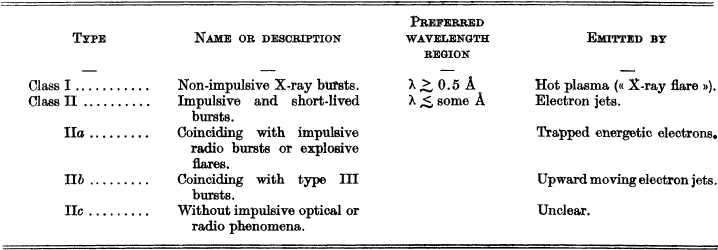Article contents
Solar X radiation
Published online by Cambridge University Press: 14 August 2015
Abstract
X-ray bursts are defined as electromagnetic radiation originating from electronic transitions involving the lowest electron shells; gamma rays are of nuclear origin. Solar gamma rays have not yet been discovered.
According to the origin we have :
-
1. Quasi thermal X-rays, emitted by (a) the quiet corona, (b) the activity centers without flares, and (c) the X-ray flares.
-
2. Non-thermal X-ray bursts; these are always associated with flares.
The following subdivision is suggested for flare-associated bursts :

On définit les sursauts de Rayons X comme une radiation électromagnétique provenant des transitions électroniques affectant les couches électroniques les plus profondes. Les rayons γ sont d'origine nucléaire. Les émissions solaires de rayons γ n'ont pas encore été découvertes.
D'après leur origine, on peut diviser ces émissions de la façon suivante : 1)
1) Rayons X quasi-thermiques émis par a) la couronne calme, b) les centres actifs sans éruption et c) les éruptions de rayons X.
2)2) Sursauts de rayons X non thermiques qui sont toujours associés à des éruptions.
On suggère de classer les sursauts liés à des éruptions de la façon suivante :
Резюме
Всплески лучей X определены как електромагнитное излучение происходящее от электронных переходов затрагивающих самые глубокие электронные слои. Лучи γ ядерного происхождения. Еще не были обнаружены излучения солнечных лучей γ.
По их происхождению, эти излучения могут быть разделены следующим образом : 1)
1) Квазитепловые луичи X, излучаемые : а) спокойной короной, 6) активными центрами без вспышки и с) вспышками лучей.
2)2) Всплески нетепловых лучей X, всегда связанные со вспышками.
Выдвинута мысль классифицировать всллески связанные со вспышками следующим образом:
Information
- Type
- Session II. X and γ Radiation : The Sun
- Information
- Copyright
- Copyright © CNRS 1965
References
- 4
- Cited by

